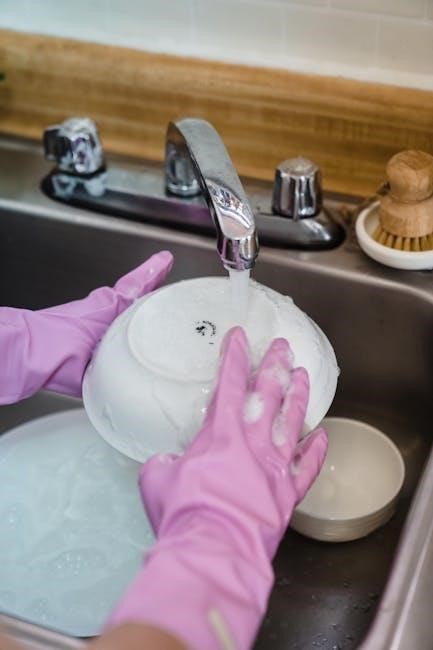Welcome to our comprehensive guide on repairing your Hansgrohe kitchen faucet․ Learn how to address common issues like leaks, low water pressure, and handle problems with ease;
Overview of Hansgrohe Faucets
Hansgrohe is a renowned brand in the plumbing industry, offering high-quality kitchen faucets known for their innovative designs and durability․ With a history spanning over a century, Hansgrohe has established itself as a leader in creating functional and aesthetically pleasing faucets․ Their kitchen faucets are designed to meet diverse needs, featuring modern styles, advanced technologies, and water-saving solutions․ From sleek pull-out models to traditional designs, Hansgrohe faucets are built with premium materials and engineering excellence․ The brand’s commitment to sustainability and water efficiency is reflected in its EcoSmart technology, which reduces water consumption without compromising performance․ Whether you’re renovating or upgrading, Hansgrohe kitchen faucets are a reliable choice, combining elegance, functionality, and long-lasting durability for a superior kitchen experience․
Importance of Regular Faucet Maintenance
Regular maintenance is crucial for extending the life of your Hansgrohe kitchen faucet․ Neglecting upkeep can lead to issues like leaks, reduced water pressure, and worn-out parts․ By addressing problems early, you prevent minor issues from escalating into costly repairs․ Cleaning and lubricating faucet components, checking for mineral buildup, and replacing worn seals can significantly enhance performance․ Proper care ensures optimal water flow, prevents water waste, and maintains hygiene․ A well-maintained faucet also preserves the aesthetic appeal of your kitchen․ Hansgrohe’s durable designs benefit from routine inspections, ensuring they continue to function seamlessly for years․ Regular maintenance is a simple yet effective way to protect your investment and enjoy a trouble-free kitchen experience․

Common Issues with Hansgrohe Kitchen Faucets
Common issues with Hansgrohe kitchen faucets include leaks, low water pressure, and loose handles, often caused by worn-out O-rings, clogged aerators, or faulty cartridges․
Causes of a Leaking Hansgrohe Faucet
A leaking Hansgrohe faucet is often caused by worn-out or damaged components such as O-rings, gaskets, or cartridges․ Over time, these parts can degrade due to water pressure, temperature changes, or mineral buildup․ The O-ring, located on the stem screw, may become loose or cracked, allowing water to escape․ Similarly, the cartridge, which controls water flow, can wear out and fail to seal properly․ In some cases, the swivel spout may leak if its seals are compromised․ Identifying the source of the leak is crucial for effective repair․ Regular maintenance, such as cleaning and replacing worn parts, can prevent leaks and extend the faucet’s lifespan․ Addressing these issues promptly ensures optimal performance and avoids further damage to the faucet or surrounding areas․
Identifying Low Water Pressure Issues
Low water pressure in a Hansgrohe faucet can be identified by a weak flow or trickle of water․ This issue often stems from clogged aerators or blocked spray nozzles, which accumulate debris or mineral buildup over time․ Additionally, kinked or improperly installed water supply lines can restrict water flow․ In some cases, the faucet’s cartridge or flow restrictor might be faulty, limiting the water pressure․ To diagnose, check the supply lines for kinks and ensure the aerator is clean․ If the issue persists, inspecting the cartridge or flow restrictor may be necessary․ Regular cleaning and maintenance can help prevent such problems and restore optimal water pressure․ Addressing these issues early ensures efficient functionality and extends the faucet’s lifespan․ Proper troubleshooting steps can help identify the root cause effectively․
Diagnosing a Loose Faucet Handle
A loose faucet handle can be caused by worn-out O-rings, a damaged stem, or improper installation․ Check the handle’s attachment point for any visible wear or mineral buildup․ If the handle wobbles excessively, inspect the stem screw or cartridge for damage․ Tightening the handle’s set screw with an Allen wrench may resolve the issue․ If the problem persists, replacing the cartridge or O-rings is necessary․ Ensure all parts are clean and lubricated during reassembly․ Regular maintenance can prevent such issues, ensuring smooth operation and longevity of your Hansgrohe faucet․ Addressing a loose handle promptly avoids further damage and maintains optimal functionality․
Tools and Materials Needed for Repair
Essential tools include adjustable pliers, screwdrivers, and wrenches․ Materials like replacement O-rings, cartridges, and gaskets are often required․ Ensure all parts are compatible with your faucet model․
Essential Tools for Faucet Repair
Repairing a Hansgrohe kitchen faucet requires specific tools to ensure efficiency and safety․ Start with an adjustable wrench or pliers for gripping and loosening components․ A screwdriver set, including Phillips and flathead options, is necessary for disassembling handles or access panels․ Needle-nose pliers can help retrieve small parts like O-rings or gaskets․ A bucket or container is handy for catching water during disassembly․ Teflon tape is useful for resealing threaded connections․ For cartridge replacements, a cartridge puller may be needed․ Silicone-based lubricant can prevent gasket sticking․ Ensure all tools are compatible with your faucet’s materials to avoid damage․ Having these tools ready will streamline the repair process and minimize downtime for your faucet․
Common Replacement Parts for Hansgrohe Faucets
When repairing a Hansgrohe kitchen faucet, common replacement parts include O-rings, gaskets, and cartridges․ The O-rings and gaskets are prone to wear and tear, leading to leaks․ The cartridge, which controls water flow and temperature, may also need replacement if it becomes worn or mineral-encrusted․ Additionally, pull-out hoses and spray heads can degrade over time, requiring renewal․ For swivel spouts, replacing the seals can resolve leakage issues․ It’s essential to identify the correct part numbers using the faucet’s model identification tag, often located near the supply lines․ Refer to the manual or manufacturer’s website for specific part details․ Always use genuine Hansgrohe replacement parts to ensure optimal performance and maintain warranty validity․

Step-by-Step Repair Guide
Start by turning off the water supply and disassembling the faucet to access internal components․ Replace worn parts like O-rings or cartridges, then reassemble and test the faucet․
Fixing a Leaky Faucet
A leaking Hansgrohe faucet can be fixed by identifying the source of the leak․ Common culprits include worn-out O-rings, cartridges, or gaskets․ Start by turning off the water supply to prevent further damage․ Disassemble the faucet handle to access the internal components․ Inspect the O-rings and gaskets for signs of wear or mineral buildup․ Replace any damaged or worn-out parts with genuine Hansgrohe replacement kits․ Ensure all connections are tightened securely․ If the leak persists, consider replacing the faucet cartridge or checking the swivel spout seals․ Regular maintenance and lubrication of moving parts can prevent future leaks․ Always refer to the user manual for specific instructions tailored to your faucet model․
Replacing the Worn-Out Cartridge
Replacing a worn-out cartridge in your Hansgrohe kitchen faucet is a straightforward process․ Start by turning off the water supply to avoid any leaks․ Open the faucet to drain excess water․ Next, remove the handle by taking out the screw or button on top, using an Allen wrench if necessary․ Once the handle is off, you’ll find the cartridge held in place by a retaining ring or clip․ Release the ring and carefully pull out the old cartridge․ Insert the new cartridge, ensuring it’s properly seated and aligned․ Replace the retaining ring and reattach the handle․ Tighten the screw securely and turn on the water supply․ Check for leaks to ensure the repair is successful․ Regular cartridge replacement helps maintain optimal faucet performance․
Repairing the O-Ring and Gasket
Repairing the O-ring and gasket in your Hansgrohe kitchen faucet is essential to stop leaks and ensure smooth operation․ Begin by turning off the water supply and opening the faucet to drain excess water․ Disassemble the handle by removing the screw or button on top, using an Allen wrench if required․ Once the handle is off, locate the O-ring and gasket, typically found on the stem or cartridge․ Inspect for wear or damage and replace them with new ones․ Apply a small amount of silicone-based grease to the new O-ring for a tighter seal․ Reassemble the faucet in the reverse order, ensuring all parts are securely tightened․ Turn the water supply back on and check for leaks to confirm the repair․ Regularly maintaining these components prevents future issues and extends the faucet’s lifespan․
Advanced Repair Techniques
Master advanced repair techniques for your Hansgrohe faucet, such as replacing the faucet hose, adjusting the handle, or fixing the swivel spout․ Follow manufacturer guidelines for optimal results․
Replacing the Faucet Hose
Replacing the faucet hose is a straightforward process that can resolve issues like leaks or reduced water flow․ Start by turning off the water supply to the faucet․ Next, disconnect the old hose from the faucet and sink connections using an adjustable wrench․ Remove any remaining debris or mineral buildup from the connections․ Install the new hose by attaching it securely to the faucet and sink, ensuring all clips and nuts are tightened properly․ Finally, turn the water supply back on and test the faucet to ensure there are no leaks․ Regularly inspecting and replacing the faucet hose can prevent major repairs and maintain optimal performance․ Always refer to the manual for specific instructions and part numbers․
Adjusting the Faucet Handle
Adjusting the faucet handle is essential for ensuring smooth operation and preventing leaks․ Start by shutting off the water supply to avoid any water flow during the process․ Remove the handle by taking out the screw or clip holding it in place․ Gently pull the handle away to access the stem and cartridge․ Inspect the cartridge for wear or mineral buildup and clean or replace it as needed․ Reassemble the handle and ensure all parts are securely tightened․ If the handle feels loose, tighten the mounting screws or replace worn-out O-rings․ Proper adjustment ensures the handle operates smoothly and maintains a watertight seal․ Regular maintenance can extend the lifespan of your Hansgrohe faucet and keep it functioning optimally․ Always consult the manual for specific guidance tailored to your model․
Fixing the Swivel Spout
If your Hansgrohe kitchen faucet’s swivel spout is leaking or not moving smoothly, it’s likely due to worn-out seals or mineral buildup․ Start by turning off the water supply to prevent any water flow during the repair․ Next, disassemble the spout by removing any retaining rings or screws to access the internal components․ Inspect the seals and gaskets for damage or buildup․ Clean or replace them as needed, using replacement parts if necessary․ For mineral buildup, consider using a descaling solution or vinegar to remove deposits․ After cleaning or replacing the parts, reassemble the spout and ensure all connections are tight to maintain a watertight seal․ Proper adjustment and regular maintenance will help extend the lifespan of your faucet and keep it functioning smoothly․ Always refer to your specific model’s manual for detailed guidance․

Maintenance and Prevention Tips
Regular maintenance is key to extending your Hansgrohe faucet’s lifespan․ Clean faucet parts regularly, lubricate moving components, and check for mineral buildup to prevent leaks and ensure smooth operation․
Cleaning and Lubricating Faucet Parts
Cleaning and lubricating your Hansgrohe faucet parts is essential for maintaining optimal functionality․ Start by turning off the water supply to prevent any leaks during the process․ Use a soft cloth and mild soap solution to wipe down visible components, such as the spout and handle, removing any mineral deposits or grime․ For Moving parts like the O-rings and gaskets, apply a small amount of silicone-based lubricant to ensure smooth operation and prevent wear․ Regularly cleaning the aerator and spray nozzle can also improve water flow and reduce the risk of clogs․ By incorporating these simple maintenance steps into your routine, you can extend the lifespan of your faucet and keep it performing like new․
Preventing Mineral Buildup
Preventing mineral buildup is crucial for maintaining your Hansgrohe faucet’s performance and longevity․ Regularly cleaning the aerator and spray nozzle can help remove lime scale and debris that impair water flow․ Descaling solutions or vinegar can dissolve mineral deposits effectively․ Drying the faucet after use, especially in hard water areas, reduces the risk of mineral accumulation․ Installing a water filter or softener can also minimize mineral content․ Scheduling annual descaling maintenance ensures optimal functionality․ By addressing mineral buildup proactively, you can prevent clogs, leaks, and damage to internal components, keeping your faucet running smoothly for years to come․
Scheduling Regular Maintenance
Regular maintenance is key to extending the life of your Hansgrohe kitchen faucet․ Schedule annual inspections to check for worn-out parts like O-rings, gaskets, and cartridges․ Replace these components before they cause leaks or reduce performance․ Additionally, clean the faucet’s aerator and spray nozzle every few months to ensure proper water flow․ For areas with hard water, consider descaling every six months to remove mineral buildup․ By maintaining a routine maintenance schedule, you can prevent unexpected repairs and ensure your faucet continues to function efficiently․ This proactive approach saves time and money while keeping your faucet looking and performing like new․ Regular maintenance is a simple yet effective way to protect your investment and enjoy a hassle-free kitchen experience․ Always refer to your Hansgrohe manual for specific guidance tailored to your faucet model․

Warranty and Customer Support
Hansgrohe offers up to a 5-year warranty on select faucet models, covering manufacturing defects․ Their customer support provides expert assistance, while online resources include manuals and spare parts shops for easy repairs․
Understanding Hansgrohe Warranty Terms
Hansgrohe offers a comprehensive warranty program, typically covering their kitchen faucets for up to 5 years from the date of purchase․ This warranty addresses manufacturing defects in materials and workmanship, ensuring faulty parts are repaired or replaced free of charge․ To benefit from the warranty, customers must register their product within 30 days of purchase․ The warranty does not cover damage caused by improper installation, misuse, or normal wear and tear, such as worn-out O-rings or cartridges․ For detailed terms and conditions, refer to the official Hansgrohe website or the product manual․ Understanding these terms helps homeowners maintain their faucets effectively and resolve issues promptly․
Contacting Hansgrohe Customer Service
For assistance with your Hansgrohe kitchen faucet, contacting customer service is straightforward․ Visit the official Hansgrohe website and navigate to the “Service” or “Contact” section․ Here, you’ll find options to call, email, or use live chat․ The 24/7 customer support ensures help is available whenever you need it․ Be prepared to provide your faucet’s model number and a detailed description of the issue for faster resolution․ Additionally, Hansgrohe’s website offers a wealth of resources, including FAQs, manuals, and troubleshooting guides, to help you address common problems independently․ Whether you need repair guidance or warranty assistance, Hansgrohe’s dedicated team is ready to assist, ensuring your faucet functions optimally for years to come․
With proper care and timely repairs, your Hansgrohe faucet will remain functional for years․ Regular maintenance and prompt issue resolution ensure longevity and optimal performance․
Final Tips for a Long-Lasting Faucet
Regular maintenance is key to extending the life of your Hansgrohe kitchen faucet․ Clean faucet parts with mild soap and a soft cloth to prevent mineral buildup․ Lubricate moving parts annually to ensure smooth operation․ Replace worn-out O-rings or gaskets promptly to avoid leaks․ Avoid using abrasive cleaners or tools, as they may damage the finish․ Inspect the faucet hose and connections regularly for signs of wear․ If you notice low water pressure, check for clogged aerators or filters․ Schedule professional maintenance annually for complex issues․ By following these tips, you can enjoy a hassle-free, long-lasting Hansgrohe faucet․
